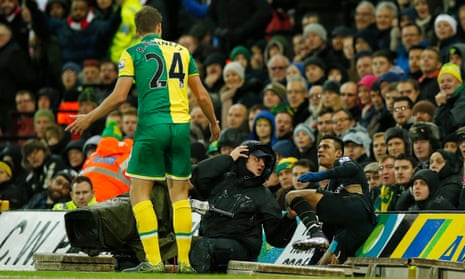Arsène Wenger has said Alexis Sánchez’s fall into the TV camera pit at Norwich City last Sunday, after a push from the defender Ryan Bennett, “could have killed him” and he suggested the jolt may have caused the Arsenal forward’s subsequent hamstring injury.
Sánchez is out for three to four weeks but the prognosis on Santi Cazorla is far worse. The midfielder, who was also injured at Carrow Road after a coming-together with the Norwich captain, Gary O’Neil, will be sidelined for at least four months with what Wenger fears is a rupture of the lateral collateral knee ligament.
Cazorla has travelled to his native Spain to see the renowned specialist Dr Ramón Cugat and Wenger did not rule out that the injury would turn out to be season-ending. He does not yet know whether surgery will be required.
Wenger was unhappy at how he felt Bennett had shoved Sánchez into the pit, which was by the side of the pitch on halfway, in the 41st minute. Sánchez had been airborne and, to Wenger, it was similar to the flashpoint from last season when Stoke City’s Marko Arnautovic pushed Mathieu Debuchy into the advertising hoardings at the Emirates Stadium.
The Arsenal full-back had been off the ground with no way of reacting. He dislocated his shoulder and was ruled out for three months. Sánchez pulled up with his hamstring problem in the 59th minute and he was withdrawn immediately. Bennett tweeted after the match that he “genuinely was trying to stop, not push, Sánchez”.
“First of all, it’s dangerous to have a camera there,” Wenger said. “Secondly, he didn’t need to push him like he did. He could have killed him. I think the camera position was absolutely dangerous. When Alexis was pushed it did not shock anybody. Nobody suggested that he could displace his back or his hamstring. The injury can come from that as well.”
Moments before Sánchez’s incident with Bennett, Mesut Özil had careered towards the photographers’ pit behind one of the goals, only to narrowly avoid it. Aaron Ramsey went into the hoardings behind the other goal in the second half. “Özil chose a space where he was free to dive in,” Wenger said. “I watched it again. He just saw that he was about to fall down [the pit] and he chose to go into a space where there was no camera.”
Cazorla was hurt in the 46th minute and it remains a mystery as to how he completed the game, even if he was a virtual passenger towards the end when Wenger had used his three substitutes. Cazorla was treated on the field and allowed to continue and, according to Wenger, despite feeling “big pain” he said he was all right to play on whenever he was asked.
Wenger understands that when the lateral ligament is only partially torn and is, effectively, still hanging on, it can pull and cause extreme discomfort whereas a complete rupture can lead to less stability in the knee but, strangely, less pain.
Cazorla could not make sharp movements but he was able to struggle through the game in straight lines. It would seem more likely that Cazorla has suffered the rupture.
“He was booked for diving when his knee let him down because he could not change direction,” Wenger said. “He wanted to cut back. I don’t understand how he carried on. I saw he was not himself, like he was against Spurs [on 8 November], when he was dizzy.
“But every time I said: ‘Santi, are you all right?’ he said he was OK. He loves so much to play. Sometimes, you don’t know how bad it is – he did not know how bad it was either. He said he had a big pain but he could play on. It could be a rupture.
“What happened to him was that the ball was in the air, he wanted to pick it out and he didn’t see O’Neil, who came in and went through him. I don’t know if he needs an operation or if it will be the whole season.
“I have to wait until we have a complete assessment from the specialist. We know his external knee ligament has been touched, and he might have a capsular problem as well, but I don’t know for how long he will be out.”
Wenger talked about the physiological and psychological damage that injuries could cause, particularly to explosive players such as Sánchez. He also said it had to be accepted “a stamina player gets injured less when he runs than an explosive player”.
“Every injury gives you a bigger chance to be injured again,” Wenger said. “That’s the biggest problem in our sport. You lose confidence in your body. I had players who, after two or three injuries, refused to sprint. Subconsciously their body tells them to be careful and they don’t even notice. For a while Cesc Fàbregas was like that because he had a few hamstring problems.
“A player who comes back [from injury] always goes through a period where the reconstruction of the muscle takes longer than the time where they don’t play. There is always a risk when a player has been out for five weeks that in the first two or three weeks he has a recurrence of the injury because nobody can tell you the risk doesn’t exist.”
